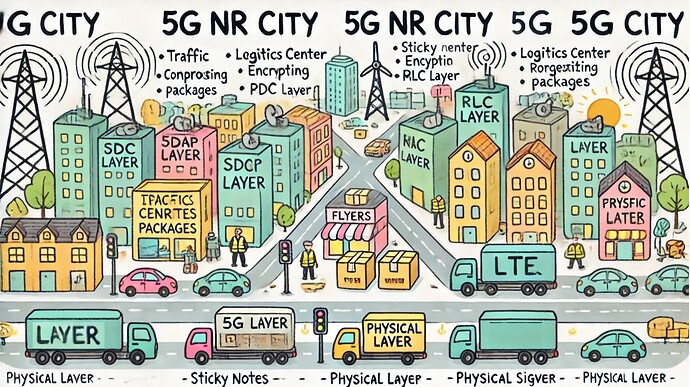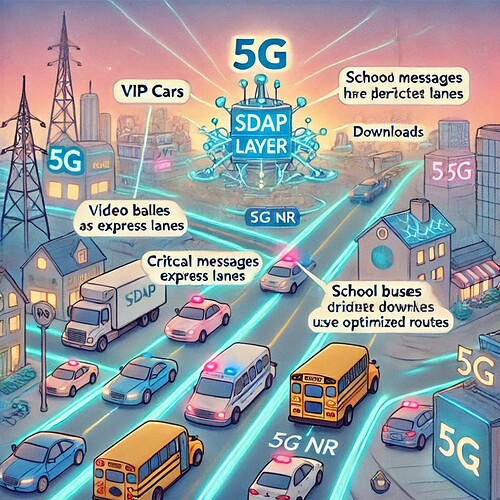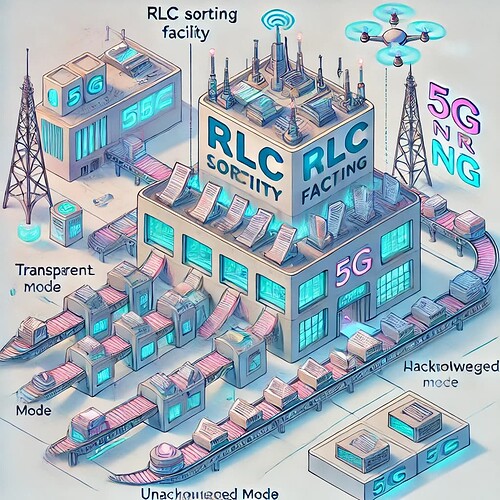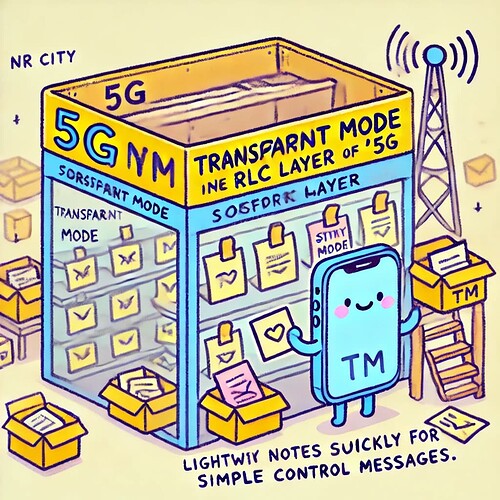This topic presents in a very simplified way all the main concepts that should be understood by those who know 5G NR.
5G NR Flow of Downlink Data
In 5G NR, the flow of downlink data begins with the SDAP Layer, which acts like traffic control, ensuring each type of data (like video calls or downloads) gets the right priority for smooth delivery. Next, the PDCP Layer compresses the data to save space, encrypts it for security, and ensures everything is in the correct order before moving forward. The RLC Layer works as a sorting facility, breaking data into smaller pieces and reassembling it at the destination. Depending on the need, it operates in Transparent Mode (TM) for quick control messages, Unacknowledged Mode (UM) for speedy delivery without confirmation (like live streaming), or Acknowledged Mode (AM) for reliable delivery with retransmissions (like file transfers). Finally, the MAC Layer acts as a distribution center, organizing the data for efficient scheduling and transmission, using smarter systems in 5G NR to handle higher speeds and wider frequencies. Together, these layers ensure data flows efficiently, securely, and reliably in 5G NR, far exceeding what LTE could achieve. [In a Nutshell: 5G NR’s data flow uses smarter layers to prioritize, secure, and efficiently deliver data, surpassing LTE.]
![]() In LTE City, packages (data) were delivered, but the system wasn’t very organized. There was no traffic police to prioritize important deliveries, the sorting centers sometimes couldn’t handle everything quickly, and the delivery routes weren’t very flexible. In the upgraded 5G NR City, everything is much smarter and faster. First, there’s a team of traffic police (SDAP Layer) that makes sure important deliveries, like ambulances (video calls), get priority lanes, while trucks (downloads) use their own routes to avoid traffic. Next, the PDCP Center compresses the packages so they’re easier to carry, locks them up safely (encryption), and puts them in the right order so nothing gets mixed up. Then, the RLC Sorting Facility cuts big packages into smaller pieces and decides how to handle them: sticky notes without envelopes (TM) for simple messages, flyers tossed in the wind (UM) for fast deliveries, or courier deliveries (AM) for important packages that need to arrive perfectly. Finally, all the packages go to the Distribution Center (MAC Layer), where they are put into boxes and loaded onto delivery trucks. The trucks then leave through the shipping docks (Physical Layer) and travel smoothly to their destinations, thanks to smart traffic lights (Physical Signals) guiding them. In 5G NR City, everything runs faster, more securely, and more efficiently than in LTE City! [In a Nutshell: In 5G NR City, smarter systems prioritize, sort, and deliver packages faster and more efficiently than LTE City.]
In LTE City, packages (data) were delivered, but the system wasn’t very organized. There was no traffic police to prioritize important deliveries, the sorting centers sometimes couldn’t handle everything quickly, and the delivery routes weren’t very flexible. In the upgraded 5G NR City, everything is much smarter and faster. First, there’s a team of traffic police (SDAP Layer) that makes sure important deliveries, like ambulances (video calls), get priority lanes, while trucks (downloads) use their own routes to avoid traffic. Next, the PDCP Center compresses the packages so they’re easier to carry, locks them up safely (encryption), and puts them in the right order so nothing gets mixed up. Then, the RLC Sorting Facility cuts big packages into smaller pieces and decides how to handle them: sticky notes without envelopes (TM) for simple messages, flyers tossed in the wind (UM) for fast deliveries, or courier deliveries (AM) for important packages that need to arrive perfectly. Finally, all the packages go to the Distribution Center (MAC Layer), where they are put into boxes and loaded onto delivery trucks. The trucks then leave through the shipping docks (Physical Layer) and travel smoothly to their destinations, thanks to smart traffic lights (Physical Signals) guiding them. In 5G NR City, everything runs faster, more securely, and more efficiently than in LTE City! [In a Nutshell: In 5G NR City, smarter systems prioritize, sort, and deliver packages faster and more efficiently than LTE City.]
Skip to: Roadmap to 5G NR
- SDAP Layer
- PDCP Layer
- RLC Layer
- RLC TM (Transparent Mode)
- RLC UM (Unacknowledged Mode)
- RLC AM (Acknowledged Mode)
- MAC Layer
SDAP Layer
The Service Data Adaptation Protocol (SDAP) layer is specific to 5G NR and didn’t exist in LTE. It maps user data to Quality of Service (QoS) flows, ensuring each type of traffic—like video calls or browsing—gets the appropriate network treatment. In LTE, QoS was handled at different levels without a dedicated layer like SDAP. The addition of SDAP in 5G allows for more granular and efficient handling of various data flows, tailored to user needs and application requirements. [In a Nutshell: SDAP in 5G NR ensures better control of traffic for different types of data, unlike LTE.]
![]() In the upgraded 5G NR City, SDAP acts like a team of traffic police that didn’t exist in the older LTE City. These police officers make sure different vehicles—like VIP cars (video calls), school buses (critical messages), and delivery trucks (downloads)—each get the right path based on their importance. VIP cars get priority, buses are always on time, and trucks use the proper routes without blocking others. This ensures smooth and efficient traffic flow for everyone, something LTE City couldn’t manage as it treated all vehicles the same. [In a Nutshell: SDAP in 5G NR works like traffic police, organizing vehicles (data types) for smoother flow, unlike LTE.]
In the upgraded 5G NR City, SDAP acts like a team of traffic police that didn’t exist in the older LTE City. These police officers make sure different vehicles—like VIP cars (video calls), school buses (critical messages), and delivery trucks (downloads)—each get the right path based on their importance. VIP cars get priority, buses are always on time, and trucks use the proper routes without blocking others. This ensures smooth and efficient traffic flow for everyone, something LTE City couldn’t manage as it treated all vehicles the same. [In a Nutshell: SDAP in 5G NR works like traffic police, organizing vehicles (data types) for smoother flow, unlike LTE.]
- Search Forum
 5G NR SDAP Layer
5G NR SDAP Layer 
PDCP Layer
The Packet Data Convergence Protocol (PDCP) layer in 5G NR and LTE serves similar functions, such as data compression, encryption, and packet reordering to ensure secure and efficient data delivery. However, 5G NR enhances PDCP functionality by supporting features like dual connectivity, which allows simultaneous data transmission from multiple base stations, enabling higher data rates and lower latency. These improvements make the PDCP layer in 5G more capable than its LTE counterpart, while maintaining its foundational tasks. [In a Nutshell: PDCP in 5G NR improves data handling with dual connectivity for faster, more efficient delivery, unlike LTE.]
![]() In both LTE City and 5G NR City, there’s a building called the PDCP Center where packages (data) are handled. The center compresses the packages to save space, locks them securely to keep them safe (encryption), and makes sure they’re delivered in the right order (reordering). But in the upgraded 5G NR City, the PDCP Center has been improved with extra delivery vans and routes (dual connectivity) that can collect packages from multiple locations at the same time. This means deliveries are faster, smoother, and can handle bigger loads, making it much better than the older LTE City’s version, which didn’t have these advanced features. [In a Nutshell: PDCP in 5G NR is a smarter delivery center with more vans and routes for faster, secure package handling than in LTE.]
In both LTE City and 5G NR City, there’s a building called the PDCP Center where packages (data) are handled. The center compresses the packages to save space, locks them securely to keep them safe (encryption), and makes sure they’re delivered in the right order (reordering). But in the upgraded 5G NR City, the PDCP Center has been improved with extra delivery vans and routes (dual connectivity) that can collect packages from multiple locations at the same time. This means deliveries are faster, smoother, and can handle bigger loads, making it much better than the older LTE City’s version, which didn’t have these advanced features. [In a Nutshell: PDCP in 5G NR is a smarter delivery center with more vans and routes for faster, secure package handling than in LTE.]
- Search Forum
 5G NR PDCP Layer
5G NR PDCP Layer 
RLC Layer
The Radio Link Control (RLC) layer operates in both LTE and 5G NR, performing segmentation and reassembly of data packets. It supports three modes of operation: Transparent Mode, which sends data without headers and is typically used for control messages; Unacknowledged Mode, which prioritizes speed and does not require delivery confirmation; and Acknowledged Mode, which ensures reliable delivery through retransmissions. These modes remain unchanged from LTE to 5G NR, continuing to serve various application needs based on reliability and efficiency requirements. [In a Nutshell: RLC in 5G NR continues to handle data in modes for speed, reliability, or simplicity, just like in LTE.]
![]() In both LTE City and 5G NR City, the RLC Layer is like a sorting facility for documents (RLC PDUs). Here, large documents are split into smaller pieces (segmentation) and reassembled when they arrive at their destination. The sorting facility works in three ways: Transparent Mode skips adding labels, making it ideal for quick notes or messages; Unacknowledged Mode focuses on speed, sending documents quickly without waiting for confirmation; and Acknowledged Mode double-checks everything, resending any missing documents to ensure nothing gets lost. The sorting facility works the same in both cities, meeting different delivery needs for reliability and efficiency. [In a Nutshell: RLC in 5G NR is a document-sorting center that handles data based on speed, reliability, or simplicity, just like in LTE.]
In both LTE City and 5G NR City, the RLC Layer is like a sorting facility for documents (RLC PDUs). Here, large documents are split into smaller pieces (segmentation) and reassembled when they arrive at their destination. The sorting facility works in three ways: Transparent Mode skips adding labels, making it ideal for quick notes or messages; Unacknowledged Mode focuses on speed, sending documents quickly without waiting for confirmation; and Acknowledged Mode double-checks everything, resending any missing documents to ensure nothing gets lost. The sorting facility works the same in both cities, meeting different delivery needs for reliability and efficiency. [In a Nutshell: RLC in 5G NR is a document-sorting center that handles data based on speed, reliability, or simplicity, just like in LTE.]
- Search Forum
 5G NR RLC Layer
5G NR RLC Layer 
RLC TM (Transparent Mode)
Transparent Mode (TM) in the RLC layer transmits data without adding protocol headers, making it ideal for transferring control messages that do not require additional processing. This functionality is identical in both LTE and 5G NR, ensuring lightweight transmission for specific network control functions where minimal overhead is critical. [In a Nutshell: Transparent Mode is used for quick, simple control messages in both LTE and 5G NR.]
![]() In both LTE City and 5G NR City, Transparent Mode (TM) in the RLC Sorting Facility is like sending sticky notes without envelopes. These notes don’t need extra labels or packaging, making them quick and easy to process. This lightweight approach is perfect for simple control instructions that don’t need additional handling, and it works the same way in both cities, ensuring these quick messages get through without any delays. [In a Nutshell: Transparent Mode sends sticky notes without extra packaging, ideal for quick control messages in both cities.]
In both LTE City and 5G NR City, Transparent Mode (TM) in the RLC Sorting Facility is like sending sticky notes without envelopes. These notes don’t need extra labels or packaging, making them quick and easy to process. This lightweight approach is perfect for simple control instructions that don’t need additional handling, and it works the same way in both cities, ensuring these quick messages get through without any delays. [In a Nutshell: Transparent Mode sends sticky notes without extra packaging, ideal for quick control messages in both cities.]
- Search Forum
 5G NR Transparent Mode
5G NR Transparent Mode 
RLC UM (Unacknowledged Mode)
Unacknowledged Mode (UM) in the RLC layer is used for data transfer where delivery confirmation is not required, focusing on fast transmission over guaranteed reliability. This mode is particularly suitable for real-time applications like live streaming, where speed is prioritized. The implementation of this mode is the same in both LTE and 5G NR. [In a Nutshell: UM in RLC sends data quickly without worrying about confirmation, perfect for real-time needs like live streaming.]
![]() In both LTE City and 5G NR City, Unacknowledged Mode (UM) in the RLC Sorting Facility is like sending flyers through the wind without checking if they reach everyone. The goal is to get the flyers out as quickly as possible, without waiting for confirmation. This is perfect for tasks like live streaming, where speed is more important than making sure every flyer reaches its destination. This mode works exactly the same way in both cities, prioritizing fast delivery over reliability. [In a Nutshell: UM sends flyers quickly, prioritizing speed over confirmation, in both cities.]
In both LTE City and 5G NR City, Unacknowledged Mode (UM) in the RLC Sorting Facility is like sending flyers through the wind without checking if they reach everyone. The goal is to get the flyers out as quickly as possible, without waiting for confirmation. This is perfect for tasks like live streaming, where speed is more important than making sure every flyer reaches its destination. This mode works exactly the same way in both cities, prioritizing fast delivery over reliability. [In a Nutshell: UM sends flyers quickly, prioritizing speed over confirmation, in both cities.]
- Search Forum
 5G NR Unacknowledged Mode
5G NR Unacknowledged Mode 
RLC AM (Acknowledged Mode)
Acknowledged Mode (AM) in the RLC layer ensures error-free delivery by implementing retransmissions for lost or corrupted data. This mode is essential for applications that require high reliability, such as file transfers or messaging services. The functionality remains consistent between LTE and 5G NR, supporting robust communication across both technologies. [In a Nutshell: AM in RLC ensures reliable delivery by resending lost data, ideal for critical applications like file transfers.]
![]() In both LTE City and 5G NR City, Acknowledged Mode (AM) in the RLC Sorting Facility is like sending important documents with a courier who ensures delivery. If any document gets lost or damaged along the way, the courier goes back and resends it until everything arrives safely. This process guarantees error-free delivery, making it perfect for tasks like sending files or important messages. The method remains the same in both cities, providing reliable communication whenever it’s needed. [In a Nutshell: AM sends important documents with a courier who ensures safe delivery by resending if needed, in both cities.]
In both LTE City and 5G NR City, Acknowledged Mode (AM) in the RLC Sorting Facility is like sending important documents with a courier who ensures delivery. If any document gets lost or damaged along the way, the courier goes back and resends it until everything arrives safely. This process guarantees error-free delivery, making it perfect for tasks like sending files or important messages. The method remains the same in both cities, providing reliable communication whenever it’s needed. [In a Nutshell: AM sends important documents with a courier who ensures safe delivery by resending if needed, in both cities.]
- Search Forum
 5G NR Acknowledged Mode
5G NR Acknowledged Mode 
MAC Layer
The Medium Access Control (MAC) layer in 5G NR retains its core role from LTE, which is to handle the scheduling and transmission of data over the air interface. However, 5G NR introduces improvements like more flexible resource scheduling and support for a wider range of frequency bands, enhancing efficiency and performance. These advancements enable the MAC layer in 5G to better meet the demands of modern applications requiring high throughput and low latency. [In a Nutshell: The MAC layer in 5G NR improves scheduling and frequency handling, making it faster and more efficient than LTE.]
![]() In both LTE City and 5G NR City, the MAC Layer acts as the Distribution Center, organizing boxes (MAC PDUs/Transport Blocks) for delivery. In 5G NR City, the Distribution Center has been upgraded with smarter scheduling systems and the ability to handle deliveries across a wider area (frequency bands). This makes it more efficient and faster, ensuring packages are sent out in a way that meets the needs of modern demands like high-speed streaming or low-latency gaming. While the core job is the same in both cities, the improvements in 5G NR City make the Distribution Center far better at managing today’s traffic. [In a Nutshell: The MAC layer in 5G NR is an upgraded distribution center, handling more deliveries faster and more efficiently than in LTE City.]
In both LTE City and 5G NR City, the MAC Layer acts as the Distribution Center, organizing boxes (MAC PDUs/Transport Blocks) for delivery. In 5G NR City, the Distribution Center has been upgraded with smarter scheduling systems and the ability to handle deliveries across a wider area (frequency bands). This makes it more efficient and faster, ensuring packages are sent out in a way that meets the needs of modern demands like high-speed streaming or low-latency gaming. While the core job is the same in both cities, the improvements in 5G NR City make the Distribution Center far better at managing today’s traffic. [In a Nutshell: The MAC layer in 5G NR is an upgraded distribution center, handling more deliveries faster and more efficiently than in LTE City.]
- Search Forum
 5G NR MAC Layer
5G NR MAC Layer 
That’s it. ![]()
-
Continue reading: Roadmap to 5G NR - System Information
-
Or back to: Roadmap to 5G NR







